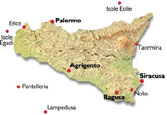 |
 |
|
Messina | ||
|
||||||||
|
I've arrived in Messina by train - from the south, and from the mainland (the train rides on a ferry - you see nothing of the strait sitting for an hour or so buried in your carriage, but hear plenty of shunting-type noises); by road (the spectacular autostrada from north or south - but a nightmare once you leave it to descend into the hellish Messina traffic); and by aliscafo (hydrofoil) - from Lipari in the Aeolian Islands. Only the last can be recommended! Fly to Reggio rather than Catania, and take a hydrofoil. You'll arrive exhilarated rather than frustrated, crossing the Stretto into the great sickle-shaped harbour (hence its original Greek name of Zankle) guarded by a Statue of Liberty-like Madonna. Across the water, the city looks quite beautiful (make the most of it!), with the new cathedral of Cristo Re perched above it, and the precipitous pine-clad Peloritani mountains as a backdrop. [Similarly one should only ever arrive in Venice by vaporetto across the lagoon from Punta Sabbioni.] The city was devastated by an earthquake in 1908, which killed 84,000 (most of the population) - so don't expect to see much that's old. Messina makes a virtue of its modernity - the traffic is lethal, and you may well spend much of your visit trying to cross the racetrack which runs north-south parallel with the shore. Where other Sicilian towns have a passeggiata on foot in the main square, in Messina this happens on motorini!
Past the museum, you will eventually reach a beach from where you can look acrosss to Calabria and the White Mountain - and speculate whether Homer ever visited this quiet stretch of water constantly criss-crossed by ferry-boats: nothing about it says "Scylla and Charybdis"! You may be tempted to go further north to the point where the massive masts carry cables back to the mainland. Imagine what a bridge (first planned in 251BC by Metellus) will eventually look like. The bridge is now (April 2004) due for completion in 2015 - it will cost €5.6bn, which will be helped by EU funding. The span of the suspension bridge will be 3.2km, supported by two towers a quarter of a mile high (400m). Wow! If you get as far as Ganzirri there are some excellent fish restaurants (locally-caught swordfish a speciality: try it smoked if you can find it) - a very lively place in the holiday season, as is Mortelle a bit further on.
A trip up into the hills is well worth it for the unbelievable views of the Stretto. You can walk or drive along the ridge through the pines for about 10k to the sanctuary of Monte Antenammare.
|
 |
Use the table below to find your way around Sicily: |  |
||||||||||
| Map | Index | PA | ME | CT | EN | CL | SR | RG | AG | TP | ||
Printer friendly page: click to print
| What's new? | Search the site? | Main Index? | Bookshop? | Top of Page? | ||||
|
The Classics Pages are written and designed
by Comments, questions and contributions welcome. |
||||||||